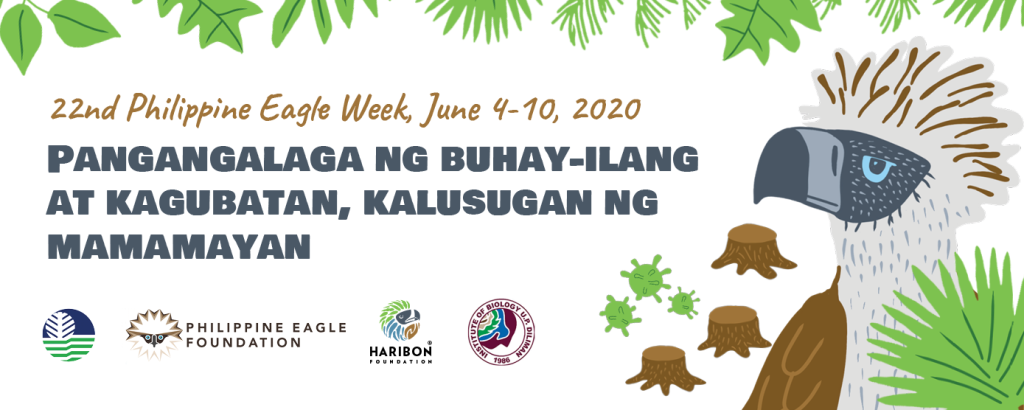
Every June 4-10 of each calendar year, we celebrate the life and survival of the Philippine eagle, our National Bird and as the flagship species in the campaign for the conservation of the rich biodiversity of the country. Now on its 22nd year, the 2020 Philippine Eagle Week is no different from the previous years, only that this year’s celebration came at a time when the country is facing a national public emergency because of a worldwide pandemic known as COVID-19, a viral disease believed to have originated from wildlife (zoonotic disease). COVID 19 has claimed thousands of lives globally, including the Philippines. The overwhelming impact of the current pandemic calls for a rational response that should foster a healthy co-existence between humans and wild animals.
With the theme, “Pangangalaga ng Buhay-ilang at Kagubatan, Kalusugan ng Mamayan”, the PEW 2020 celebration shall seize the opportunity to help communities understand the critical role of wildlife conservation in preventing emergence of zoonotic diseases to avoid similar pandemics in the future.
Wildlife are natural reservoir of naturally occurring viruses. Because the virus and wild animals have evolved together, it has little to no effect on those wild animals. However, when transmitted to a new hosts like humans or livestock, a virus can result to an infectious disease with debilitating health effects and possible sustained human to human transmission across geographic areas affecting large portion of human population.
The emergence of zoonotic diseases has steadily increased in recent decades, with 75% of these diseases attributed to pathogens with origins in wildlife reservoirs. In particular, mammalian species, especially bats, are increasingly recognized as important reservoirs for zoonotic viruses, including paramyxoviruses (e.g., Hendra and Nipah henipaviruses), filoviruses (e.g. Ebola and Marburg viruses), and coronaviruses (e.g., SARS-, SADS-, MERS-CoVs). Wild birds may also harbor viruses which are precursors of highly pathogenic strains of influenza virus e.g. H5N1, H5N6, etc. (FAO, 2012).
The destruction and conversion of natural habitats, including wildlife hunting and trade removed boundaries between wild animals and humans (including livestock), bringing humans into increased contact with wildlife and associated pathogens, and thus the risk of disease spillover to humans and livestock. Fragmentation of habitats may also stimulate more rapid evolutionary processes and diversification of diseases (UNEP, 2016).
Thus, the best way to prevent the occurrence of infectious diseases from wild animals is to:
• Protect remaining wildlife habitats;
• Restore damaged ecosystems to bring back stability to natural environments;
• Promote various area-based conservation measures such as protected areas and indigenous and community conserved areas);
• Strictly comply with wildlife regulation to ensure that wildlife trade is sustainable, legal, and safe.
As we celebrate the 2020 PEW, we call on the Filipino people to embrace conservation of wildlife and their habitats as our way of life in the “new normal” for the perpetuation of the Philippine eagle, and other wildlife, and to prevent the occurrence of similar pandemics in the future.
Among the activities for the 2020 PEW at the national level is an Art contest for grades 10-12 and a webinar on Philippine eagle conservation.
Link for Details:



